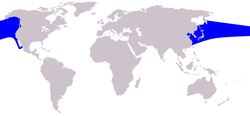Pacific White-sided Dolphin
|
|
| Pacific White-sided Dolphin Conservation status: Lower risk | ||||||||||||||||||
|---|---|---|---|---|---|---|---|---|---|---|---|---|---|---|---|---|---|---|
| Missing image Pacific_white_side_dolphin.jpg | ||||||||||||||||||
| Scientific classification | ||||||||||||||||||
| ||||||||||||||||||
| Binomial name | ||||||||||||||||||
| Lagenorhynchus obliquidens (Gill, 1865) | ||||||||||||||||||
 Pacific White-sided Dolphin range |
The Pacific White-sided Dolphin (Lagenorynchus obliquidens) is a very active dolphin found in the cool to temperate waters of the North Pacific Ocean.
| Contents |
Taxonomy
The Pacific White-sided Dolphin was named by Theodore Gill in 1865 who examined three skulls found washed up in California. It is the only species of the genus Lagenorhynchus to be found in the North Pacific. To this end the dolphins are sometimes simply called "lags" by researchers and fisherman working in these seas. (A similar naming convention applies in the north Atlantic with the Atlantic White-sided Dolphin - although in that case there is a slightly greater chance of confusion.)
The Pacific White-sided Dolphin is extremely similar morphologically to the Dusky Dolphin, which is found in the southern part of the Pacific. Some researchers have suggested that they might form a single species. Recent genetic work by Cipriano rejects this hypothesis and suggests the two species diverged about two million years ago.
Physical description
The Pacific White-sided Dolphin has three tones of colour. The chin, throat and belly are creamy white. The beak, flippers back and dorsal fin are a dark grey. There is light grey patch on the sides and a further light grey stripe running from above the eye to below the dorsal fin where it thickens along the tail stock. A dark grey ring surrounds the eyes.
The species is of average size for a oceanic dolphin - weighing up to 150kg in females and 200kg in males and growing up to 2.5 metres (male) and 2.3 metres (female) in length. Pacific White-sided Dolphins tend to be rather larger than Duskies. Females reach maturity at 7 years. The gestation period is one year. Individuals can live for upto forty years or more.
The Pacific White-sided Dolphin is extremely active and mixes with many of the other cetacean species to be found in the north Pacific. It also readily approaches boats and bow-rides. Large groups are common - on average 90 individuals per group but supergroups of more than 3,000 have been recorded. Prey is mainly lantern fish, hake, anchovies, squid, herring, salmon and cod.
Population and distribution
The range of the Pacific White-sided Dolphin runs right in a great arc across the cool to temperate waters of the north Pacific. Sighthings go no further south than the South China Sea on the western side and the Baja California peninsula on the eastern. Populations may also be found in the Sea of Japan and the Sea of Okhotsk. In the northern part of the range, some individuals may be found in the Bering Sea. The dolphins appear to follow some sort of migratory pattern – on the eastern side they are most abudant off the California shore in winter, but further north (Oregon, Washington) in Summer. Their preference for off-shore deep waters appears to be year-round.
The total population may be as many as 1 million. However such is the tendency of Pacific White-sided Dolphins to approach boats from some distance away, it is harder than usual to obtain precise estimates via sampling.
Human interaction
Until the United Nations imposed a ban on certain nets in 1993, many Pacific White-sided Dolphins were killed in drift nets. One researcher estimated somewhere between 50 and 89 thousand individuals were killed in the twelve years to 1990. Some animals are still killed each year by Japanese hunting drives, though these are not expected not to cause a threat to the species at the present time.
References
- Pacific White-sided Dolphin and Dusky Dolphin by Koen van Waerebeek and Bernd Wessig Encyclopedia of Marine Mammals pp859-860 ISBN 0125513402
- National Audubon Society: Guide to Marine Mammals of the World ISBN 0375411410
- Encyclopedia of Marine Mammals ISBN 0125513402de:Wei▀streifendelfin
